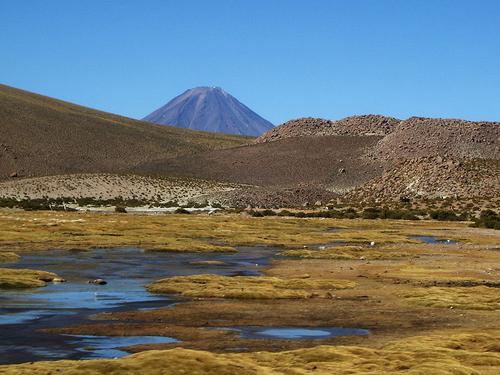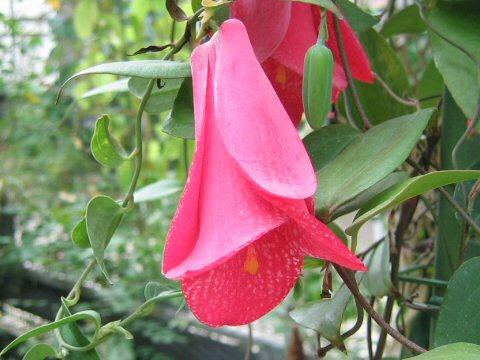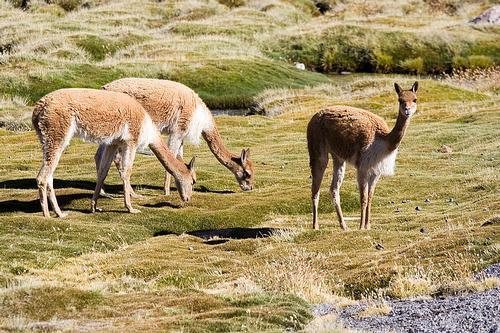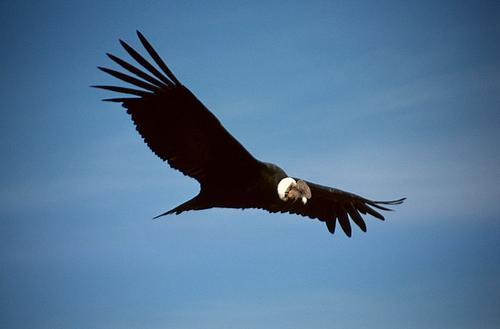CHILE
Plants and Animals

Plants and Animals

Cities in CHILE
| Santiago |
Plants and Animals
Plants
Due to the climatic and geological conditions, Chile has no tropical flora. The fairly isolated location means that many species occur that cannot be found anywhere else, especially along the desert coast and in the temperate rain forests.
From north to south, the flora changes dramatically due to the decrease in temperature and the increase in the amount of rain. In the north almost barren deserts, at the height of Santiago Mediterranean scrub and further to the south evergreen rain forests. In the far south we find tundra vegetation and on the arctic peninsula only snow and ice.
From east to west the change of vegetation is even more spectacular. At a distance of 50-100 km the vegetation changes from evergreen rainforest, through deciduous deciduous forest to dry, very flora-poor semi-desert.
Brief description of the different ecosystems in Chile:
Atacama Desert
Especially on the edges of the desert, the plants have adapted to the very difficult conditions. Small oases in the middle of the desert with salt-loving thorn bushes and trees are called "tamarugales". The trees are widely spaced, including the thorny tamarugo tree and the chañar shrub. Where a lot of mist floats in, mist forests have been created. The vegetation that arises here is called loma vegetation, with various types of cacti, lichens, thorn bushes and tillantia species, plants with almost no roots that filter their water from the air with their leaves. The transition zone from the Atacama Desert to the Altiplano is characterized by the candlestick cactus and the columnar cactus.

Altiplano highland steppe
On the dry grass steps or "pampas" grows mainly "tola" and "paja brava", two hard grasses."Bofedales" are wet areas in the north, where between 4000 and 5000 meters altitude some rocks are covered with azorella cushions. They are also known as "yaretas" or "llaretales". These very compact plants were used as firewood in the past and are not so common anymore. The only tree species in the Altiplano, the Queñoa, has also become quite rare.
Semi-deserts
The semi-deserts of the "Little North" are already much more densely covered with cacti and thorn bushes. Furthermore, bromeliads or "puyas", herbs and grasses also grow here. When it rains a lot, the desert turns into a sea of flowers that lasts for several weeks. A rare "loma cloud forest" has emerged in Fray Jorge National Park, with tree species that are otherwise only found in southern Chile.
Mediterranean forests
The original deciduous forest in central Chile has been reduced to a few remnants in the coastal mountains and in the Andes valleys. These mainly consist of an acacia species and extensive areas with high bushes and cacti. Beautiful euphorbias and bromeliads grow in between. The other forests here consist of the native species quillay (cork oak), naiten, radal, boldo and peumo, especially east of Valparaíso. The forests of Chilean palm trees are also special in this region, a protected species of which only about 200,000 copies remain. Juice can be extracted from the stem and concentrated to syrup.
 Lapageria ChilePhoto: Shu Suehiro CC 3.0 Unported no changes made
Lapageria ChilePhoto: Shu Suehiro CC 3.0 Unported no changes made
South Chilean forests
The very humid zone along the ocean coast consists of temperate rainforests with a three-layer structure. First of all, a high tree layer with beech species such as tepa, canelo, mañio, tineo, roble and coigüe and conifers in the very swampy and mountainous parts of the rainforest.
Below is a low tree and shrub layer with tree species such as arrayán and fuinque. Lianas, bromeliads, ferns, mosses and lichens hang from the branches of these trees. Remarkable are the large tree ferns, beard mosses and in some places large fields with quila bamboo species. Another special appearance from the rainforest is the nalca, a giant rhubarb eaten by the Chileans. One of the most striking plants is the Lapageria rosea or copihue of the lily family, which has large red bells and is considered the national flower of Chile. The forest floor is covered with a decimetre thick layer of leaves, mosses and liverworts. Hundreds of species of moss grow in these forests, even more than 400 species on Tierra del Fuego. In the southern rainforest zone, the Valdivian rainforests are distinguished and the southernmost forests on earth are the Magellanic rainforests. On the islands in this region, tree growth is no longer possible due to the harsh climate, here we only find heather and swamp areas.
At an altitude of 1000-1500 meters and on the east side of the Andes, forests with deciduous deciduous trees occur, including lenga and ñirre. The beautiful "nothro", a shrub with a fiery red color, also grows in these lenga forests. Above the sharp tree line there are suddenly no more trees, due to the climate the tree line on Tierra del Fuego is already at 500 meters.
Alerce and araucaria coniferous forests are found high in the Andes of the Chilean-Argentine lake area. The araucaria (snake pine) is a 40 to 50 meter high tree with a palm-like trunk and a screen-like crown of branches. The Chileans speak of umbrella trees or "Los Paraguas". At least 200 million years ago these trees already grew here and they were found all over the world. Trees with an age of more than 2000 years are no exception because they grow very slowly. This special tree has a protected status throughout Chile. The alerce is related to the giant sequoias of North America. These trees can also reach a height of 50 meters and reach an age of more than 4000 years. They are therefore among the oldest living creatures on earth. They mainly live on steep slopes in the high mountains, in lowland swamps and in isolated forests in the Valdivian rainforest. It is not known how many of these trees there are.
Patagonian steppe
The plateaus on the eastern side of the Andes Mountains are completely without trees. The vegetation here consists of grasses and thorny shrubs such as the calafate. After heavy rain showers, many annual bulbous plants bloom on the steppe.
Southern Islands
On the outer islands along the coast of Chilean Patagonia and Tierra del Fuego, there is also treeless vegetation, with mainly heather and peat plants, the so-called "Tundra Magallanica".
Animals
The climate, landscape and vegetation are the factors that produce a highly varied animal world. Due to its isolated location, many ecosystems and fauna of their own have developed with many endemic species, especially along the west coast of the country. Unbridled hunting practices, poorly enforced conservation laws, and an expanding population are major threats to Chile's wildlife.
Brief description of the animal life in the different ecosystems of Chile:
Atacama Desert
Much of the Atacama Desert is completely lacking animal life; only at the edges of the desert are some animals, toads, frogs near the rare places where there is water, and also turtles, small lizards and some snake species. Most animals live on the desert coast. On the border of the cactus rock desert and the highland steppe, the gorges are the preserve of beautiful birds such as the pit's woodpecker and the Inca bird.

Altiplano
On the Chilean Altiplano, large numbers of wild vicuñas live in the "bofedales," the wet grasslands. Wild guanaco is still alive in the lower parts. The dry highland steppe includes the very rare deer species huemul, cougars, foxes, vizcachas and about 130 bird species.
Most notable bird species are the rhea, an ostrich-like, eagles, condors, and many thousands of flamingos, including the Chilean flamingo, James's flamingo and the Andean flamingo. Meadow and water birds are the giant coots, pennywort and various duck species.
The spectacled bear, the only bear species in South America, is still found in the north in the Andes. Wool mice, family of the chinchilla, are found up to 4000 m altitude. Tooth-poor animals include the lesser belt mouse or shield mole.
Forest animals
The South Chilean forest has few bird species due to a lack of insects. There are no dangerous animals except cougars. One of the few other predators is the shy fox.
Remarkable is the rare pudu, a dwarf deer with unbranched antlers that resides in the dense undergrowth. Furthermore, the huemul, also a rare deer species.
Common is the Patagonian woodpecker, with deep black plumage and a male with a bright red head. Special birds are also the Austral parakeet, the very rare Trichue parrot and the Picaflor austral, the most southerly common hummingbird. Many owls and bats become active at night. The beautiful bandúrria, a yellow-brown ibis, lives in swampy areas and along rivers. Mountain streams are home to the rare torrent duck or pato de los torrentes, a beautifully colored duck.
Patagonian steppe
The most famous animals of the Patagonian steppe are the armadillo, an armadillo, and the mara or Patagonian hare. The guanaco is a llama species that lives in groups of 10 to 30 animals. An impressive sight is also the rhea, the South American ostrich. The ferret, Patagonian fox, Fireland fox and cougar hunt the rhea and the guanaco.
Many birds live on the steppe. A beautiful flightless bird is the tinamou or martinetta and near lakes and ponds live among others bandúrria, highland goose, black-necked swan, coscoroba swan and the Chilean flamingo. Small animals are the prey of years, owls, falcons and eagles, including the carancho. The steppe also has the necessary scavengers, such as the condor, the chimango, the carara and the Turkish vulture.

Andean high mountains
Well-known apparitions in the high mountains are the vizcacha, a rodent, and the condor. The condor is the largest bird of prey on Earth, with a maximum wingspan of 3.20 meters. The bird is still revered by the Native Americans and is Chile's national bird.
Coasts and seas
Many animals live in the plankton-rich cold sea currents that flow along the Chilean coast. Many so-called "guano birds" live on the islands, which produce valuable fertilizer. The main guano birds are cormorant, gannet and brown pelican.
Fulmars and albatrosses live on the open seas in the south. The Royal Albatross is the largest bird in the world with a maximum wingspan of 3.5 meters.
Seven species of penguins live on the coasts of Chile, six of which are in Patagonia and Tierra del Fuego, the rockhopper penguin, the throat-band penguin, the macaroni penguin, the gentoo penguin, the king penguin and the Magellanic penguin. The Humboldt penguin lives on a few islands in the northern coastal area.
The oceans around Antarctica are home to about 20 species of whales (including blue whales and orca) and nine species of dolphins. Furthermore, the elephant seal, the southern sea lion and the southern seal. Rare is the sea otter or "chungungo".
Sources
Asal, S. / Chili
Lannoo.
Caistor, N. / Chili : mensen, politiek, economie, cultuur
Koninklijk Instituut voor de Tropen / Novib.
Castillo-Feliú, G.I. / Culture and customs of Chile
Greenwood Press.
Dwyer, C. / Chile
Chelsea House Publishers.
Filippo, H. / Chili
Elmar.
CIA - World Factbook.
BBC - Country Profiles.
Copyright: Team The World of Info